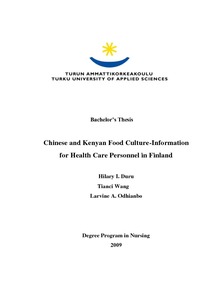Chinese and Kenyan food culture -information for health care personnel in Finland
Duru, Hilary; Odhiambo, Larvine; Wang, Tianci (2009)
Duru, Hilary
Odhiambo, Larvine
Wang, Tianci
Turun ammattikorkeakoulu
2009
All rights reserved
Julkaisun pysyvä osoite on
https://urn.fi/URN:NBN:fi:amk-200912087416
https://urn.fi/URN:NBN:fi:amk-200912087416
Tiivistelmä
This study examines the food cultures of Asian and African countries in general. It concentrates on Chinese and Kenyan food cultures and compares the Chinese and Kenyan food habits with Finnish food habits as well. The contents are based on the results from an extensive review of the literature including articles, books and internet resources on this and related topics. The result of the literature review is affirmed by the results of group discussions carried out by the authors with immigrants and some Finnish people. The respondents for the group discussions (n=14) are from Finland, China, Malaysia, South Korea, Nepal, Kenya, Nigeria, Ghana, Cameroon, Morocco. The purpose was to find out what food cultures exist in these foreign cultures and how they differ from Finnish food culture.
The results of this study confirm that people living in different parts of the world have different eating habits which are determined by their culture, beliefs, people and geographic location. The results also show that when people move from place to place they take their culture along.
The outcome of this project is a brochure which contains basic food ingredients and food habits of Chinese and Kenyan cultures. This information is made available to Finnish nurses with the aim of improving their understanding of foreign food cultures. Nurses need this knowledge to be competent in multicultural nursing which involves the comprehensive understanding of background, cultures and food preferences of people from various cultures.
The results of this study confirm that people living in different parts of the world have different eating habits which are determined by their culture, beliefs, people and geographic location. The results also show that when people move from place to place they take their culture along.
The outcome of this project is a brochure which contains basic food ingredients and food habits of Chinese and Kenyan cultures. This information is made available to Finnish nurses with the aim of improving their understanding of foreign food cultures. Nurses need this knowledge to be competent in multicultural nursing which involves the comprehensive understanding of background, cultures and food preferences of people from various cultures.
